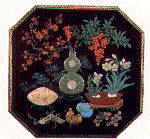Design Arts -- Lacquer Art
Lacquer is a natural substance obtained from the lacquer tree. The tree is indigenous to China, and that is why China leads the world in lacquer resources. When an object is coated with lacquer, it can no longer be distinguished as being made from a certain of material, therefore, all objects coated with lacquer are referred to as lacquerware. Lacquerware is moisture-proof and resistant to heat, acid, and alkali, and its color and luster can easily last beyond a few hundred years, adding beauty to its practical use. Many different areas are fit to grow the lacquer or varnish tree, but most of the raw lacquer comes from 5 provinces: Shaanxi, Hubei, Sichuan, Guizhou and Yunnan.

|
Tradition
Lacquerware extends back to the remote ages of China. Lacquer-painted black pottery objects existed during the Neolithic Age. Ancient Chinese found that the sap of lacquer trees has a strong adhesive quality as well as a beautiful gloss, and so it was used as a protective, adhesive, and beautifying agent for implements. Between the 8th and 3rd century B.C., lacquerware appeared in its most exquisite form, and became extremely desired by the upper class. Some of the pictures and patterns on lacquerware included dragons, snakes, phoenixes, birds, scenes of court singing, gardening, and hunting. Before the invention of ink, lacquer was used for writing. Twenty-eight bamboo clips found in a Warring States (475-221 B. C. ) tomb at Changtaiguan, Xinyang, Henan Province, bear a list of the burial objects with the characters written in lacquer. By the 15th century A.D., lacquerware was flourishing so much that the imperial household created special offices to produce it.
Today
Beijing, Fuzhou and Yangzhou are the cities leading in the production of Chinese lacquerware.

|
Yangzhou lacquerware is recognized not only by its carvings but also by exquisite patterns inlaid with gems, gold, ivory, and mother of pearl. The products are normally screens, cabinets, tables, chairs, vases, trays, cups, boxes and ashtrays.
Fuzhou is well-known for "bodiless lacquerware", one of the "Three Treasures" of Chinese arts and crafts (the other two being Beijing cloisonne and Jingdezhen porcelain). The bodiless lacquerware starts with a body of clay, plaster, or wood. Grass linen or silk is pasted onto it, layer after layer, with lacquer as the binding agent. After the outer cloth shell has hardened, the original body is removed. The shell is then smoothed with putty, polished, and coated with layers of lacquer. After being carved, it becomes the bodiless lacquerware of extremely light weigh and superb finish.



 Chinese Culture
Chinese Culture